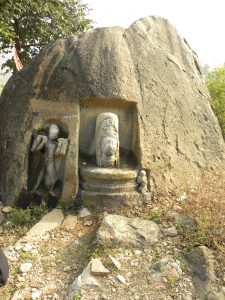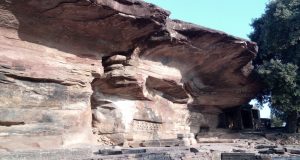IN03029 Perimiyankulam Rock Inscription
The inscription was found near Perimiyankulam or Perumäiyaṉ-kuḷam, “the tank of the great personage”, or Perumäiyāṉa-kuḷam, “the great tank”, situated on the path to Galkaḍawala, one and a half miles north of the Sacred Bōdhi-tree at Anurādhapura. Müller (1883: 27) describes the inscription as “on a flat rock by the side of a hollowed-out cave”. There are many stone pillars near the place, which is north-west of the Laṅkārāmaya. The inscription is on the whole very well preserved. It consists of 4 lines recording a gift of revenue, derived from water supply in Palinakaraka tank in Tihalaka-karisa and in Ketavalika tank at Amanaratana, to a thēra named Majibuka (or -bika) for looking after certain dilapidated buildings at Patnagala belonging to the architect Ayisayi, son of Batakaya, keeper of the royal store.
IN03022 Vessagiri Rock B Inscription 2
Vessagiri, or more commonly in Sinhalese Vessagiriya, is the traditional name of a forest-bound cluster of rocks in Anurādhapura. The site features three hummock-boulders of gneiss rock in a line from north to south (Rock A, Rock B and Rock C). The hummocks are surrounded by the ruins of a monastery, which had its cells in the caves of Rocks B and C (twenty-three caves in total). Some of the caves are inscribed with dedications to the Buddhist priesthood, plus there are a number of other rock inscriptions at the site.
The present inscription is engraved on the eastern face of Rock B. In 1904, Don Martino de Zilva Wickremasinghe noted the existence on an inscription – or possibly two inscriptions – in this area but he was unable to make out their contents. Two decades later, Senarath Paranavitana gave a more detailed account of the inscriptions on this part of the rock, identifying four separate records, one of which is dealt with here (for the others, see IN03169, IN03170 and IN03171). None of these four inscriptions is dated. However, they can be assigned on palaeographic grounds to the sixth century A.D. It is also significant that one (the present inscription) refers to Boya-Opulavana-Kasapi-gari (P. Bodhi-Uppalavaṇṇa-Kassapagiri) and another (IN03171) mentions Kasaba-giriye. These were alternative names for the ancient monastery of Issarasamaṇa-vihāra, which Paranavitana connects with modern Vessagiriya. This monastery was richly endowed by king Kassapa I, who renamed the foundation after himself and his two daughters, Bodhi and Uppalavaṇṇā, as reflected in the inscriptions here. Hence these records must postdate Kassapa I’s accession to the throne, which Paranavitana places around 526 A.D. All four inscriptions record how certain named individuals obtained freedom from slavery for themselves or their relatives. In one of the inscriptions (IN03171), this freedom is said to have been granted after payments were made to the monastery, suggesting that the monastery owned the slaves in question.
IN03021 Vessagiri Rock B Inscription 1
Vessagiri, or more commonly in Sinhalese Vessagiriya, is the traditional name of a forest-bound cluster of rocks in Anurādhapura. The site features three hummock-boulders of gneiss rock in a line from north to south (Rock A, Rock B and Rock C). The hummocks are surrounded by the ruins of a monastery, which had its cells in the caves of Rocks B and C (twenty-three caves in total). Some of the caves are inscribed with dedications to the Buddhist priesthood, plus there are a number of other rock inscriptions at the site, including the present record.
INIG1304b Chanderi Inscription of VS 1304b
INIG1304b vaiśākha śudi 1 guruvāra Chanderi (Guna). Rock inscription on the pass known as ghāṭī Number of lines not given, nāgarī, local dialect. Damaged.
INIG1300 Pahārgarh inscription of VS 1300
INIG1300 Pahārgarh (Shivpuri). On an image of Śeṣaśāyin on a rock in the Sindh river. 1 line, nāgarī, Sanskrit. Purport not given.
INIG999 Rakhetra Inscription of VS 999
INIG999 āśvina badi 30, Rakhetra (Guna). Rock inscription. 5 lines, old nāgarī, Sanskrit. Mentions irrigation works on the river Urvaśī (modern Urra) provided by Vināyakapāladeva; also mentions the gopagirīndra but this person is not named; written by Bhailadaman son of śrī Kṛṣṇarāja The inscription also carries the date 1000 bhādrapada śudi 3.
Kalinjar Inscription of Vasanta: Balkandeswara
Rock inscription at Balkhandeswara on the northern slope of the hill fortress of Kalinjar in the Banda district in Bundelkhand, Uttar Pradesh. The inscription which mentions a sāmanta named Vasanta is placed above a sculpture showing a water carrier, which is itself placed to the left of an ekamukhaliṅga. Several other such figures are found at Kalinjar. See Hans T. Bakker, The World of the Skandapurāṇa. Northern India in the Sixth and Seventh Centuries. Leiden/Boston: Brill, 2014: 205-209.

Badoh Pathari (बड़ोह पठारी), Vidisha district, Madhya Pradesh. Saptamātṛkā Panel
Badoh Pathari (बड़ोह पठारी), Vidisha district, Madhya Pradesh.

General view of rock shelter.
The Saptamātṛkā panel is at the right-hand side of a large rock shelter with a small, possibly artificial, cave shrine and the remains of some small, later temples. It depicts seven goddesses in bhadrāsana on separate bench-like seats and, at the far left, a male figure in lalitāsana on another bench, identified as Śiva because he is ithyphallic. This row of eight is in a recessed panel carved into the rock, about 50 centimeters high and 280 centimeters wide and 60 to 120 centimeters above the current ground level, which slopes to the right. An inscription (see EDITIONS) occupies a smoothed and slightly recessed area about 100 centimeters wide and 30 tall, immediately to the right of the group. The upper edges of the sculpted panel and the inscribed one are level. There are no further associated sculptures, but the rock surface is similarly smoothed in a second panel above the inscription, where traces of a painting are discernible.
Bihar Kotra Inscribed Rock Shelter
A rock shelter in the face of a cliff, probably enlarged artificially, but the surfaces are not even and there are no carved architectural elements nor any decorative carving. The shelter is shaped like a rough quarter sphere. The inscription is about 150 cm above the floor on the right-hand side of the back wall. The inscribed area is not marked off from the wall surface in any way.
Badoh-Pathari Saptamatrka Panel Inscription
This extremely weathered inscription (see IMAGES) accompanies the Saptamātṛkā panel on Gyānnāth Hill in Badoh-Pathari (Vidisha District, Madhya Pradesh). The inscription was reported by M. B. Garde (Annual Report of the Archaeological Department, Gwalior State for Samvat 1980, Year 1923-24, p. 12) who mentioned that the name of viṣayeśvara mahārāja Jayatsena could be read in it along with a partial date, the 13th of a bright half-month. The area has been surveyed by Anne Casile and reported in “Changing Religious Landscapes in Gupta Times: Archaeological Evidence from the Area of Baḍoh-Paṭhāri in Central India,” South Asian Studies 30 (2014): 245-268; the inscription studied and published by Dániel Balogh, “The Badoh-Pathari Saptamātṛ Panel Inscription,” Indo-Iranian Journal 65, no. 3 (2019): 191-226. Please note: the Sanskrit text here is for ready reference only; readers are directed to the most recent edition in Indo-Iranian Journal, see CONCORDANCE.